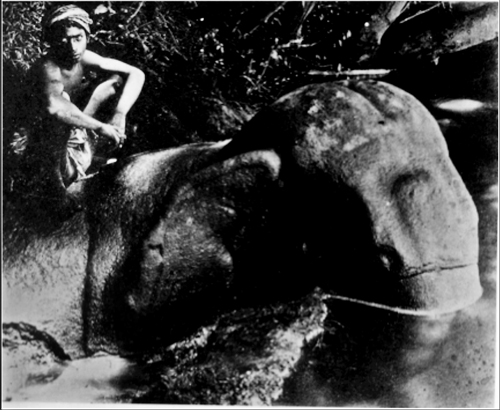The secret of ‘Gal Aliya’ : Unsolved, unrevealed and now gone forever

Boy astride the Rock Cut Elephant.(H.C.P.Bell,1898).Reproduced in the article by H.C.P.Bell -The ”Gal Aliya“or “Rock Elephant” at Katupilana, Tamankaduwa (1917).
It is indeed so sad that the wish and prayers of H.C.P. Bell, recorded as the last two sentences of his article on the ‘Gal Aliya’ of Katupilana, Tamankaduwa, that appeared in the ‘The Ceylon Antiquary and Literary Register’, Volume III, Part II of 1917 could never be fulfilled. Bell said, “The secret of the ‘Gal Aliya of Katupilana’ remains inscrutable. Will it ever reveal itself?”
The enigma of this less known masterpiece by a ‘Gal Waduwa’ of a bygone era surfaced in the article by Ismeth Raheem on a river journey in a rudderless bamboo raft (the Sunday Times- October 13, 2019). The reproduction of a photograph showing a local boy atop the ‘Gal Aliya’ from Bell’s paper was indeed very clear showing the majestic beast, life-like, about to cross the cascading Mahaweli.
This magnificent creation, a proud remnant of our cultural heritage, by the Mahaweli at Katupilana, Tamankaduwa is apparently no more. According to the Sunday Times article mentioned above, the villagers of Katupilana had told the author author that it was no more, blasted to pieces by the cruel hands of treasure hunters.
As a preamble to the now revealed tragedy of the ‘Gal Aliya’ let me quote Bell. He says, “ Full- front elephant relievos, though usually in stucco, were employed to build up the revetment of the salapatala maluwa or inner paved platform of Ruwanveli Dagaba, as well as the stylobates of other structures at Anuradhapura (Jetawanarama, Tholuwila) and more modern sites, e.g. the warder elephants of the dagaba basement at Gadaladeniya Vihare, Central Province. These and other instances which will readily occur to those acquainted with the ‘Ruined Cities’ are, nevertheless, all of a stereotyped form of relief carving (high, medium and low) repeated ad libitum whenever desired. But the elephant in his natural environment, untrammelled by conventional adaptation to sacred edifices, few examples of the sculptor’s art seemingly exist in the island”. Bell cites two examples, one above the pokuna of the Isurumuniya temple and the other among the ruins below the bund of Tissa weva. “The dark-grey granite ‘Gal Aliya’ at Katupilana, the subject of this note holds the position halfway between the alto relievo figurines in guard stones and the whole-round figures above mentioned”.
Bell, as Archaeological Commissioner in 1897, while visiting Egoda Pattuwa, Tamankaduwa, visited the site of “Gal Aliya’. According to him the sculpture was in reality a full sized elephant, carved out of the bedrock lining the left bank of the Mahaweli. In Bell’s words, “…The pseudo-beast, fronting and in exceptional relief, owing to the perfectly adapted situation and surroundings, its size and its attitude – half submerged with head slightly turned upstream as though reconoitering before wading or swimming across the river – looks from a short distance, very much like in the flesh and very much alive”. The guides had indicated to Bell that the ‘Gal Aliya’ is in a kneeling position. Because the water level was high the figure below the eye and the ear was not visible. But the head he says was carved wonderfully and very true to life both in its outline conformation and size.
M. H. Storey, an English sportsman, ten years later recorded his visit to the site in his book, “Hunting and Shooting in Ceylon”. Both Bell and Storey record seeing sockets cut into the rock above the sculpture, probably for supporting a roof. Both emphasize that there were no inscriptions or any other clue to be seen to date the sculpture or a clue to its Gal Waduwa or his benefactor.
The long list of questions that arose in the mind of Bell at the time is true to this day. His sentiments in his own words were, “for how many centuries of the island’s history has this ‘monarch of the forest’ stood in his wooded seclusion and natural haunts, gazing up-river? How came he to be fashioned and located at a site now so obscure? What was the true raison d’être of this unique sample of fauna sculpture? Was its creation due to the pure foible of a vain Gal Waduwa, or does the ‘Rock Elephant’ represent the petrified representation of some erstwhile ‘Kandula’ whose deeds his Royal Master desired thus to perpetuate amid environment so congenial to his living compeers? Neither rock record, nor palm-leaf chronicle affords any clue.”
This magnificent ‘Gal Aliya’ was still seen luxuriously wallowing in the flowing waters of the Mahaweli in 1964. (See The Sunday Times, October 13, 2019). Only God is witness to the fate of the ‘Gal Aliya’ that survived unharmed for centuries. This marvel of a sculpture certainly did not deserve the blows with sledge hammers or perhaps with dynamite by heartless desecrators
My own explanation to the discovery of the sockets cut into the rock above is that some form of a shelter was in place for the sculpture which was probably carved out of the bedrock on the left bank of the river, on solid ground. Over the centuries the course of the river would have shifted the flow thus partly inundating the sculpture and the surrounding boulders. It is sad to hear that such a magnificent sculpture is no more. The secret of the ‘Katupilana Gal Aliya’ remains deeply embedded in the lost heritage of our land, unsolved and unrevealed.


